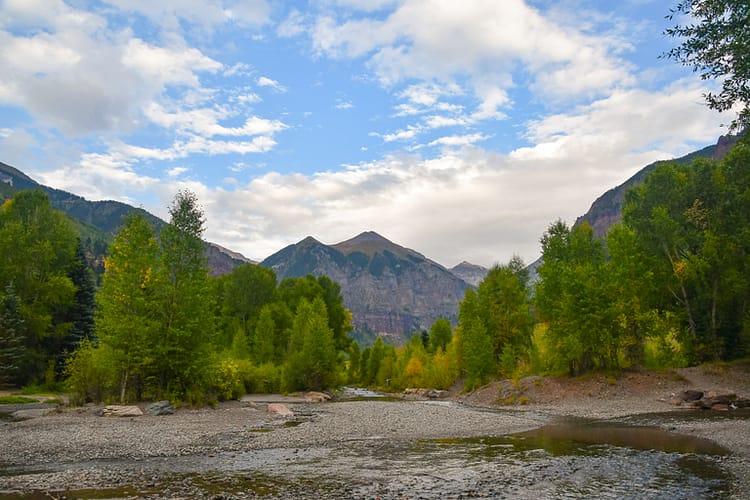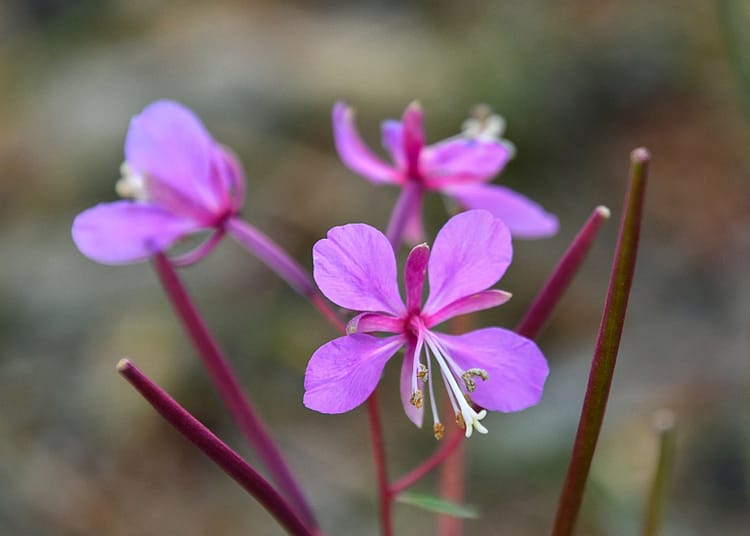After visiting the Colorado Western Front, with much of our time in the high desert areas, we were ready for Telluride, aspens and high elevations in the national forest. We spent two rainy nights in Telluride, in their town campground tucked away at the end of the box canyon. Our next stop was the Silverthorne area, to visit with our nephew and find a boondocking spot away from it all. We ended up staying three nights in the Arapaho National Forest, close to the Williams Fork, a tributary of the Colorado.
We heard weather reports of rain and flash flooding on our way to Telluride. As we were driving in, traffic was backed up, and work crews were removing landslide debris from the roadway. Uh-oh. We found our campsite, set up the Belladome, and surveyed the campground since we were surrounded by water. Bernie’s engineer mind immediately concluded that our site was well situated if there was flooding, as the campsites behind us would be inundated first! That was reassuring…


Telluride, Colorado: Bella’s Wild Gondola Ride
The next morning, it was cool and the clouds looked heavy and dense. We had two nights in Telluride, with rain in the forecast. We decided to walk around downtown and then take the gondola to the top to check out the views from above Telluride. Dogs are allowed on the gondola- and Bella will go anywhere that her people go- even if it scares her. So we got her in between us and hustled her onto the moving gondola. She was shaking with fear, and thankful once we reached the top and scrambled out of the gondola. We briefly considered hiking back down, just in case she refused to get back on for the return trip.

Great Dane posers 
Bella recovering from the gondola ride
The views were gorgeous, despite the bands of clouds that were slowly obscuring the mountains. It was much cooler, and as we walked about, a light mist was forming.

But who could miss the opportunity to take in these views? And we found some late season wildflowers, which always makes me happy.

We watched the shifting stratocumulus clouds, draped heavily across the sky above Mountain Village, and decided that a hike would not be a good idea. As we walked back towards the gondola station, fat raindrops pelted us.

Hiking back down wasn’t a good option, especially since we didn’t know the trail conditions. Bella got back on the gondola, more willingly and gracefully than the first time! We had to close the windows on the gondola as the rain pelted the sides. Fortunately, the rain didn’t last long, and we had a chance to to eat lunch on a patio and stroll about downtown.

The next morning, misty conditions were once again the norm, and we decided to take a short walk to this waterfall before packing up. We had a long drive ahead to reach Silverthorne and find a campsite for boondocking.

Arapaho National Forest boondocking
People often use the term “boondocking” to describe different types of camping arrangements. Boondocking is different than “dry camping”, which is basically parking your RV anywhere to sleep- Walmart, Cabela’s, rest areas etc. With dry camping, there are no hook ups, water, facilities, etc- you just park and hope for the best. Boondocking, however, refers to dry camping in remote areas.
Our camper van, Flora the Explorer, has a 12 volt system powered by 200 watts of solar panels, and two lithium batteries. Our refrigerator runs off the 12 volt system, as does the fan for the propane heater when the temperatures are low enough. We mostly rely on Luci solar lights, but we have backup 12 volt lights in the van. As long as we get some sunshine, we can go for a week or more on the batteries and solar. For cooking, we have a two burner propane stove inside, and we carry a 2 burner for propane cylinders to use outdoors- mostly if we are cooking fish or meat. Along with a cassette toilet, a 20 gallon water tank, and a shower that we’ve only used once, we are good to go for boondocking.



We visited with our nephew, and looked forward to seeing him again in a few days. Our destination was an area in the Arapaho National Forest, where Bernie had been elk hunting a few years ago. We found a great spot at about 9000 feet in elevation, near the Williams Fork. It provided good shade, a fire ring, and a hidden privy built in the pines. (Full disclosure- the privy was gross but functional). It gave us a good place to hang out just before the Labor Day weekend began, because no one wants to be looking for a place to camp on a holiday weekend, right?

One side of the Williams Fork is marked by a wildfire from August 2020, where nearly 15,000 acres burned. The landscape was already showing signs of recovery, with fireweed and other vegetation springing up amidst the blackened remnants of fallen trees. https://news.mongabay.com/2021/06/rocky-mountains-are-burning-more-now-than-ever-and-it-could-get-worse/
Our boondocking spot was quiet and restful. The array of wildflowers defying the scorched earth was another reminder of nature’s resilience. Wildfires are an inherent part of our ecology, but the simple economics of losing homes and other capital investments often takes precedence over what is best for the forest in the long haul.

I had plenty of time to wander about with my camera, taking in the scenery, wildflowers and other herbaceous plants that reminded me of home. The second day we were there, we had quite a rain/wind storm, and we figured out that more than a third of our trip thus far was marked by rain. We jokingly called ourselves the rainmakers, ending the drought. Cause if we go camping, in all likelihood, it will rain!




The blues and purples of the harebell and lupines were so soothing. These colors are my favorite among wildflowers, because they are less common than all the other colors. Every time I go to the Rockies, my wish is the same: I want to go in peak wildflower season. Next year….
Shit happens…
The one downside to our campsite was the multi-use nature of national forests. I am all for sharing space for different types of recreation. However, on our last night, just before dark, Bella rolled in horse manure, head to tail. It was too late to take her down to the Williams for a bath; the only choice was to wipe off the manure that was embedded in her collar, ears and all down her side. Bella is normally is quite prissy, preferring to jump over mud and creeks rather than get her feet wet! Well, she is now in touch with the smellier part of nature.
Shit happens and the stench was unreal. We put her coat on her to tamp down the smell and called it a night…but I was convinced my nostrils were coated with horse manure. The next morning, we took her to a DIY dog wash in Frisco. That place ROCKS!!! After her bath, she pranced around downtown Frisco like the princess that she is, gathering admirers. Meanwhile, we were waiting for the horse manure laundry to dry so we could get on the road.
Ute Pass, Ptarmigan Peak Wilderness
As we were leaving the Arapahoe National Forest, we stopped at Ute Pass before going to the dog wash. A few years ago, we hiked in the other direction, in Hole Creek. It was later in the season, and the aspens were at their peak, golden discs shimmering in the breeze. Today, it was quite warm and still a bit hazy from the wildfires. We didn’t make it all the way to Ute Pass, but it was a lovely hike, with a steady uphill grade and long range views for the soul.


Another happy memory in the books! Next up is a few days in Denver with friends and then the Bridger-Teton National Forest in Wyoming. Stay tuned for an upcoming post- it was one of our favorites of the entire trip. Stay well, and make memories out there, wherever you are!


